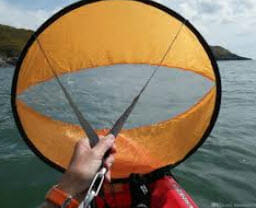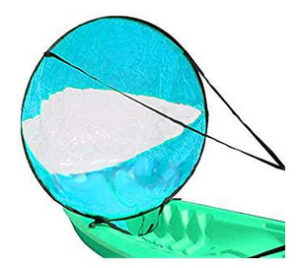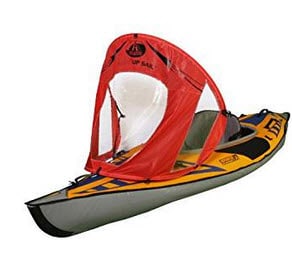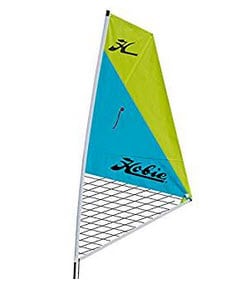What are the Different Types Of Kayak Sails?
 When you’re choosing a kayaks sail a lot of the times people are perplexed as to which model they need for which kayak and what is the deal with all of these different types of kayak sails out there. It can be confusing for someone who is just getting into the sport when they go to their local shop or shop online and see over six different types of kayak sails. You can’t figure out what you want until you know what the pros and cons of each kind of kayaks sail are only then can you decide whether this is the specific type you’re looking for. Don’t be fooled all of the kayaks sail types are in fact different, and some provide advantages over the other as well some are much more suited for a beginner whereas others are better suited for experts. Choosing the wrong sail and getting a more advanced version may lead you to become incredibly frustrated if you’re only trying to use it for a quick timeout rather than a professional hobby.
When you’re choosing a kayaks sail a lot of the times people are perplexed as to which model they need for which kayak and what is the deal with all of these different types of kayak sails out there. It can be confusing for someone who is just getting into the sport when they go to their local shop or shop online and see over six different types of kayak sails. You can’t figure out what you want until you know what the pros and cons of each kind of kayaks sail are only then can you decide whether this is the specific type you’re looking for. Don’t be fooled all of the kayaks sail types are in fact different, and some provide advantages over the other as well some are much more suited for a beginner whereas others are better suited for experts. Choosing the wrong sail and getting a more advanced version may lead you to become incredibly frustrated if you’re only trying to use it for a quick timeout rather than a professional hobby.
Firstly I would like to list the different types of sails in order of proficiency needed to use each one.
Circle shape sails, beginner
V-shaped sail, beginner to intermediate
V-shaped parachute sail, beginner
Tall L-shaped sail, intermediate to advanced
The Different Types of Sails
 Circle Shape Sail
Circle Shape Sail
This is the most popular sail out there for beginners.
The circle shape sail was created with the beginner in mind. The sail usually comes made out of a type of plastic with the visor in the middle. Now the size of the visor may vary, but we found that the larger the visor, the better your ability to be able to see objects moving at you. However, usually, the visor material is a thinner plastic so the rest of the material has to compensate and the visor material can be damaged by the sun. The rest of the circle shape sail is a large circle style parachute that usually comes with hooks that can be positioned on the back end of your kayaks bungee area or the front-end. Now for each kayak, the way you place these hooks will vary as for some you may put them at the front, and for others, you may have more hooks at the side of your kayak. These circle shaped sails come with lots of different parts that allow them to be very adjustable to different kayaks. It is not meant for any specific model and can be adjusted to most different rigs. The most significant positive of this type of circular shape sail is that it is straightforward to use and install. This makes it perfect for a beginner that doesn’t know the different intricacies of installing an L-shaped sail. All you do is clip it on, prop it up, and you let the wind take care of the rest for you. The great thing about this type of sail is the simplicity you can pretty much understand what’s happening since the wind grabs the sail and moves it along forward.
The biggest negatives with this sail type are the speed since a lot of the circle shaped models are not very fast they do grab the wind, but they will not move you along as quickly as you may have hoped. Now, this does depend a lot on how windy the day is but the circle shape sails or a bit limited in speed because of their size.
This should not deter you from buying them as they are great to have especially on a lake or the sea.
For a comprehensive guide on kayak sails please go to our kayak sail guide by clicking HERE.
 The V-shaped sails
The V-shaped sails
These sails were made accessible by a couple of smaller manufacturers like falcon sails that have started to create better materials and quality versions of the sails. They are similar to the circle shape sails however the big difference is the shape. Also, a large difference is the material since a lot of these are made with a more durable design. Many of these sails also have a similar visor in the middle that allows you to see to the other side.
One of the biggest cons with the sails is their surface area is much smaller which means that they do in fact grab a lot less wind than a parachute style circle sail. By catching less wind, this sail moves you along much slower than a circular sail typically would.
They do makeup with their slower speed by adding better materials for the sails. A lot of the V-shaped sails are made out of a more durable type of design that allows the sail to continue functioning for extended periods of time. Also because they are smaller, there are fewer issues with you pushing or knocking about while kayaking.
 V-shaped parachute sail
V-shaped parachute sail
These sails are a bit of a mix between the V-shaped sail and the circle sail in the sense that they provide the shape of the V-shaped sail and the parachute-like capabilities of the circle shape sail. They are very similar to the circle shape sail and the fact that they grab more wind and push along the kayak. The significant design change here is strictly the shape and the fact that the sail itself can be draped over the kayak to grab as much wind as possible. This type of sail is not as popular, but they are seen in some of the inflatable kayak models such as the advanced element models.
 Tall L-shaped sail
Tall L-shaped sail
These are the Cadillacs of sailing they are large professional sails that usually come in a large L-shaped style and can be fitted directly onto your kayak and adjusted to move left or right or any which way depending on where the wind is going. The most significant positive of the sails is your ability to be able to switch different directions depending on where the wind is going because of the sailing rig you can grab wind speed and travel at very fast paces while being able to adjust your direction on the go. Another significant positive is the fact that a lot of these sails are adapted to be higher up, and this higher up adjustment allows you to be able to see in front of you without any interference or having the need to have an additional visor. This type of sail is the soundest however it is also the most complex to install and the most complex to understand how to use.
Which brings us to the negatives, the negatives of this type of sail is the complexity. This complexity makes it so that as a sailor you need to find out exactly how to first install this rig on your kayak. The installation of this rig could mean that you do have to make aftermarket changes including drilling holes and installing new rigging to your kayak to be able to support the specific sail. The new equipment may include you drilling within the kayak and putting in new screws to this kayak so that the sail will be held up. The next point in complexity is the fact that you have to learn how to manage and use the sail you have to understand how to be able to grab different winds and how to adapt and move your kayak without tipping over or without having any issue while being able to function and use the winds.
Final Words
As you can see you need to know what you need the sail for before you purchase the sail. For beginners, we recommend starting off with something like a circular sail which will help you figure out how to get started with the sport and once you improve and decide that you want to professionally partake in kayak sailing you can then go ahead and upgrade to an L-shaped sail. I hope you learned a lot from this guide and as always happy kayaking.
